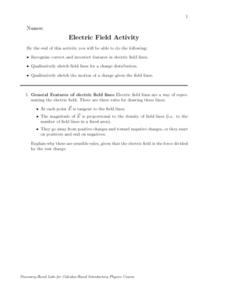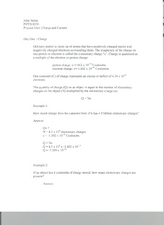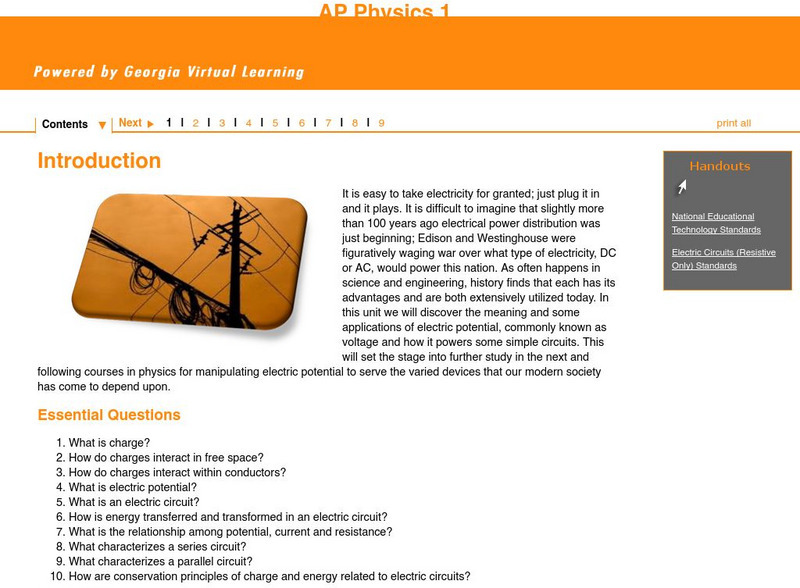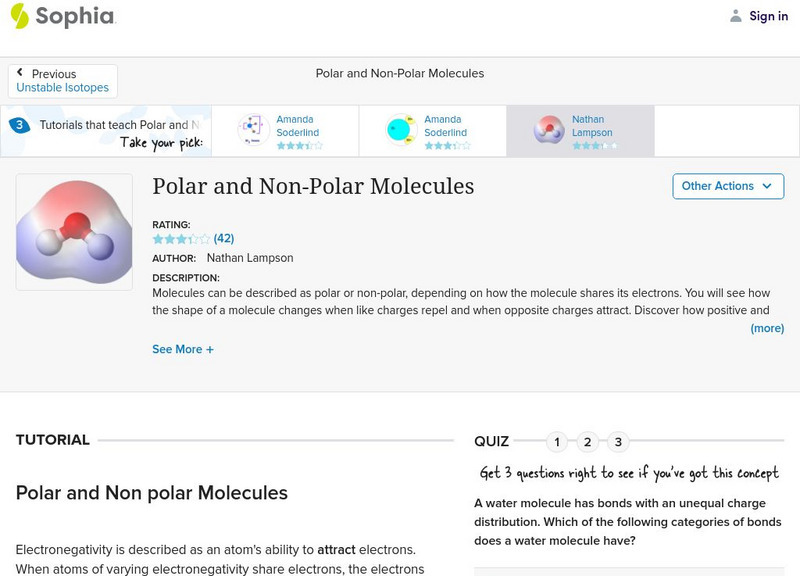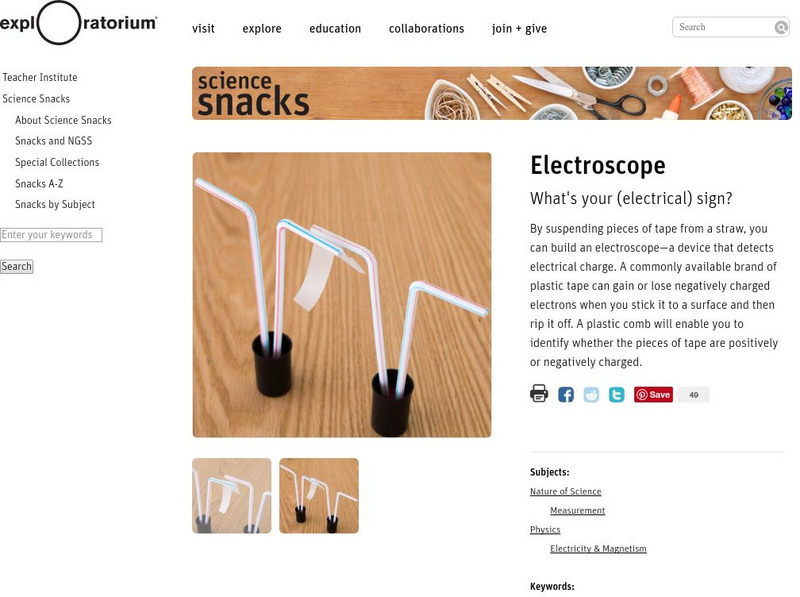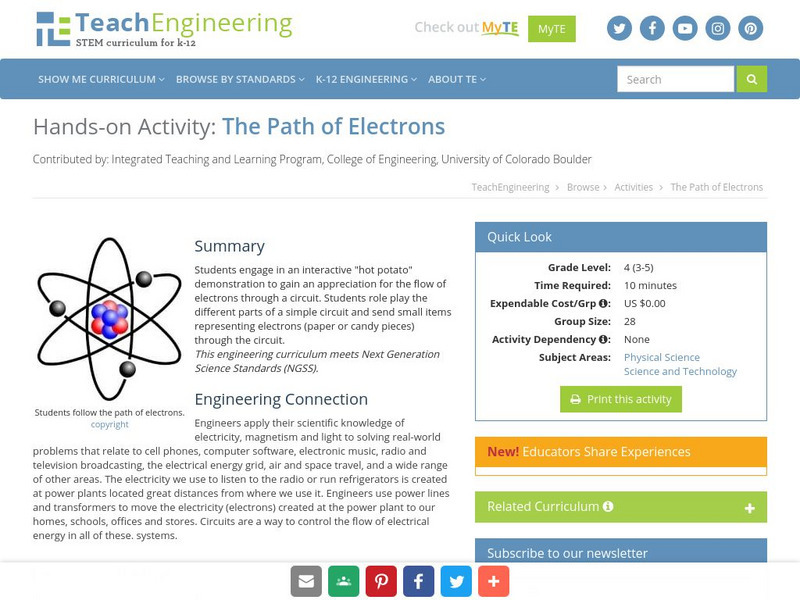Curated OER
Simple Atomic Structure
Atomic structure is reviewed with connection to the gain or loss of electrons. The movement of electrons and the resulting behavior is summarized. Practical uses of static electricity is explained, with diagrams of the most common...
Curated OER
Jumpin' Pepper and Lazy Salt
Students examine the result of a negative charge. After rubbing a balloon with a wool cloth, students hold it over a mixture of salt and pepper. They observe the pepper "jumps" to the balloon. Students discuss their observations and then...
Curated OER
Chemistry: elements
In this chemistry instructional activity students complete a set of multiple choice and short answer questions on protons, electrons, ionization and chemical equations.
Curated OER
Chemistry: Atoms
In this chemistry worksheet students complete a series of multiple choice and short answer questions on elements, chemical reactions and balancing equations.
Curated OER
Electricity
In this electricity instructional activity, students answer 17 questions about charges on atoms, their number of protons and electrons, the attraction of atoms or objects when charged, the electricity between two objects, grounding and...
Curated OER
Electric Field Activity
For this physics worksheet, students identify and describe the correct and incorrect features in electric field lines. Then they qualitatively sketch field lines for a charge distribution and a charge given the field lines.
Curated OER
TE Activity: Yogurt Cup Speakers
Sixth graders build a speaker as they investigate the roles of electricity and magnetism. They discover the properties of magnets, create an electromagnet, and determine the direction of a magnetic field. They show cause and effect...
Curated OER
Bolts Out of the Blue
Students research different types of lightning patterns and compare their origins to an experiment on static electricity. They research different types of lightning, and explain how different light patterns result from those charges.
Curated OER
Atoms and the Periodic Table
Familiarize your new chemists with the periodic table of elements by contemplating this collection of slides. Element groups are identified, atoms are defined, and nuclide notation is explained. Isotopes are also mentioned. The topics...
Curated OER
Charge and Current
Students explore how all matter is made up of atoms and how they have different charges. In this current lesson students complete several word problems and see how the rate of flow of electric charges works.
Curated OER
Wimshurst Machine
Learners examine what a Wimshurst machine is and how it operates. In this mechanics lesson students build a Wimshurst machine and watch it in action.
Curated OER
Electroscope
Students examine what an electroscope is and who invented it. In this electrical lesson students build their own Emergency Radiation detector Electroscope.
Curated OER
Capacitors
Students explain the concepts of charge storage and how a capacitor works. They construct a capacitor and measure the stored charge using the appropriate equipment and measurements. They also demonstrate capacitance and how it can be...
Science Buddies
Science Buddies: Where There Is Charge, There Can Be Sparks!
In this short science project you will learn how to build a capacitor using common household items. By testing different charge cycles, you will work to discover how much charge is stored in a Leyden jar capacitor.
Science Buddies
Science Buddies: The Strength of an Electromagnet
Has anyone ever told you that you have a magnetic personality? Have you ever heard that opposites attract? These common phrases are both based on the properties of magnets and magnetic electricity. In this science fair project, learn how...
University of Kentucky
Elecroscope Lab
This site is actually a lab from the University of Kentucky Electrical Engineering Department. It is an excellent experiment that can be done at the high school level.
Georgia Department of Education
Ga Virtual Learning: Ap Physics 1: Electric Circuits
In this unit students discover the meaning and some applications of electric potential, commonly known as voltage, and how it powers some simple circuits.
Georgia State University
Georgia State University: Hyper Physics: Capacitors
Online university physics text called "Hyperphysics". Three sections here: Capacitors, Capacitor Combinations, Charge on Series Capacitors. These are nice clean lessons, good illustrations, many hotwords to assist. A fine online lesson,...
Wolfram Research
Wolfram Science World: Capacitor
A rather mathematical explanation of a capacitor. Gives all the appropriate formulae, with many hotwords for further info.
Sophia Learning
Sophia: Polar and Non Polar Molecules: Lesson 1
This lesson will introduce polar and non-polar molecules, explaining their location, charge, and mass. It is 1 of 3 in the series titled "Polar and Non polar Molecules."
Exploratorium
Exploratorium: Science Snacks: Electroscope
In this activity, students will build electroscopes from common materials. With their electroscopes, students can then conduct experiments to find out what happens to charged objects.
TeachEngineering
Teach Engineering: The Path of Electrons
Students engage in an interactive "hot potato" demonstration to gain an appreciation for the flow of electrons through a circuit. Students role play the different parts of a simple circuit and send small items representing electrons...
TeachEngineering
Teach Engineering: Lights Out!
This lesson introduces the concept of electricity by asking students to imagine what their life would be like without electricity. Two main forms of electricity, static and current, are introduced. Students learn that electrons can move...
CK-12 Foundation
Ck 12: Chemistry: Oil Drop Experiment
[Free Registration/Login may be required to access all resource tools.] Explains how Robert Millikan determined the charge of an electron.







